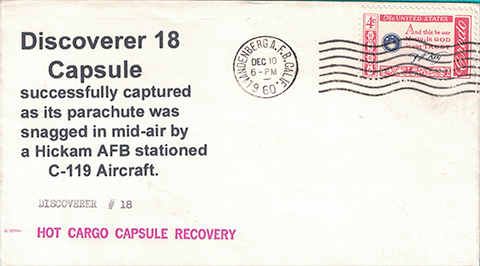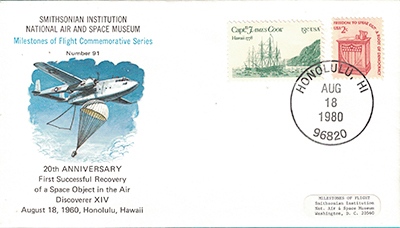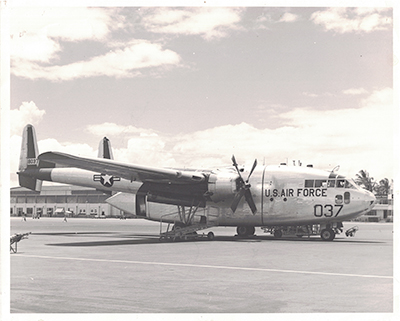|
|

|
|
Author
|
Topic: Space Cover 708: Discoverer recoverer
|
cvrlvr99
Member Posts: 204
From: Arlington, TX
Registered: Aug 2014
|
 posted 07-02-2023 10:20 AM
posted 07-02-2023 10:20 AM
   
Space Cover of the Week, Week 708 (July 2, 2023) Space Cover 708: The Discoverer RecovererAbove is a cover postmarked on December 10, 1960 at Vandenberg AFB, CA when the Discoverer 18 photo intelligence satellite was launched from there. After several polar orbits over the Soviet Union, the Discoverer 18 capsule re-entered and its' parachute was snagged in mid-air by an Air Force C119 "Flying Boxcar" cargo plane near Hawaii, hence the notations in the cachet of the cover. This also happened to be the day that I reported for duty at Hickam AFB in Hawaii which was also home of the Air Force 6593rd Test Squadron (Special) that performed the Discoverer recoveries. Discoverer was a cover name for the classified Corona satellite designed to go into polar orbit, take photos of the Soviet Union for several orbits, then bring its' film home to an air recovery. The first twelve Discoverers failed for various reasons. Discoverer 13, which did not carry a photo payload, could not be snagged out of the air but splashed down and was recovered in the Pacific. The first Discoverer air recovery was with Discoverer 14 on October 18, 1960. The closest to an event cover for that recovery that I have is the Smithsonian Milestones of Flight #91 cover, postmarked in Honolulu on the 20th anniversary of the recovery (shown below).  The aircraft that recovered Discoverer 14 was C-119 tail number 18037 flown by USAF Captain Harold Mitchell, co-pilot Richmond Apaka, a winch operator, four loadmasters, a photographer, a navigator, and a flight engineer. Mitchell received the Distinguished Flying Cross for this mission while the other crew members received the Air Medal, and the 6593rd received the 1960 MacKay Trophy Unit Award. The photo below of 18037 was taken by one of my barracks mates, A2c Sal Montanino, who worked in the base photo lab and gave me this photo. C-119 tail number 18037 is now on display at the National Museum of the United States Air Force in Dayton, OH.  Twin engine C-119 aircraft were used for this purpose up until June, 1961 when replaced by four-engine JC-130 aircraft, more suitable for extended over-water operations. Between 1960 and the end of the Discoverer (Corona) Program in 1972, 153 canisters of film were recovered. |
Axman
Member Posts: 42
From: Derbyshire UK
Registered: Mar 2023
|
 posted 07-02-2023 12:35 PM
posted 07-02-2023 12:35 PM
  
I believe there are just eleven recovery events that were serviced with covers, all of them for the Discoverer series. Not all the Discoverer missions after Discoverer 14 were successful, but the success rate did increase substantially, and all of the missions that had a capsule recovery saw "recovery" cacheted covers.The first two, Discoverer-14 and Discoverer-17 were cacheted by George Goldey alone, until Discovere-18 was covered by others as well. Discoverers 25, 26, 29, 30, 32, 35, 36 and 38 all had recovery cover cachets by multiple cachet makers. I have only two examples in my collection, Holden's Discoverer-26 and Discoverer-29 capsule recovery covers. After Discoverer 38 the Corona (KeyHole) launches were classified, and by that stage of the program a midair recovery was becoming normal, but I know of no "recovery covers" for the classified launches. |
cosmos-walter
Member Posts: 794
From: Salzburg, Austria
Registered: Jun 2003
|
 posted 07-02-2023 05:12 PM
posted 07-02-2023 05:12 PM
   
The spy satellite Discoverer 17 was launched on Nov. 12, 1960 at 8:38 p.m. UTC (12:38 p.m. PST) from Vandenberg Air Force Base, 15 km northwest of Lompoc, California. It went into an elliptical Earth orbit at an altitude between 190 and 984 km. The U.S. Air Force used Corona satellites to observe the Soviet Union, China, and other countries. Each Corona satellite was equipped with 9,600 m of a special 70-mm film. As the film unspooled ahead of schedule, however, no more than 52 cm were left for recording images. Originally, the return capsule had been planned to be severed after 17 orbits. In the end, it was ejected on Nov. 14, 1960 at 2:31 p.m. PST in 31st orbit after a distance of 1.4 million km. At 3:05 p.m. PST, Captain Gene W. Jones needed one single attempt to retrieve the capsule with a C-119 Pelican II at an altitude of 3 km. Discoverer 17 carried 28 letters. They were dispatched on Nov. 15, 1960 by the post office of Sunnyvale, California and delivered to their addressees — high military and politicians — by post. Most letters either made their way into a museum or were lost. Only two letters are known to be in private possession.  The letter to the Commander-in-Chief of the U.S. Army, General Lyman Lemnitzer, contains the flown message of the Commander-in-Chief of the U.S. Air Force, General Thomas White. The other one is addressed to NASA Administrator T. Keith Glennan. Instead of the message, it is accompanied by a non-flown data sheet by USAF press officer Colonel W.G. Woodbury; Nov. 15, 1960, 12:43 p.m. PST, is the misleadingly recorded launch time. The letter from Postmaster General Arthur Summerfield to President Dwight D. Eisenhower is severely torn. Both the envelope and the letter are incomplete. On June 21, 1966, Eisenhower donated it to the Archbishop of New York, Cardinal Francis Spellman, as part of a larger collection. Today, the Discoverer 17 Space Letter addressed to the President is housed at the Spellman Museum of Stamps & Postal History in Weston, Massachusetts. | |
Contact Us | The Source for Space History & Artifacts
Copyright 2023 collectSPACE.com All rights reserved.

Ultimate Bulletin Board 5.47a
|
|

|
 advertisement advertisement

|















